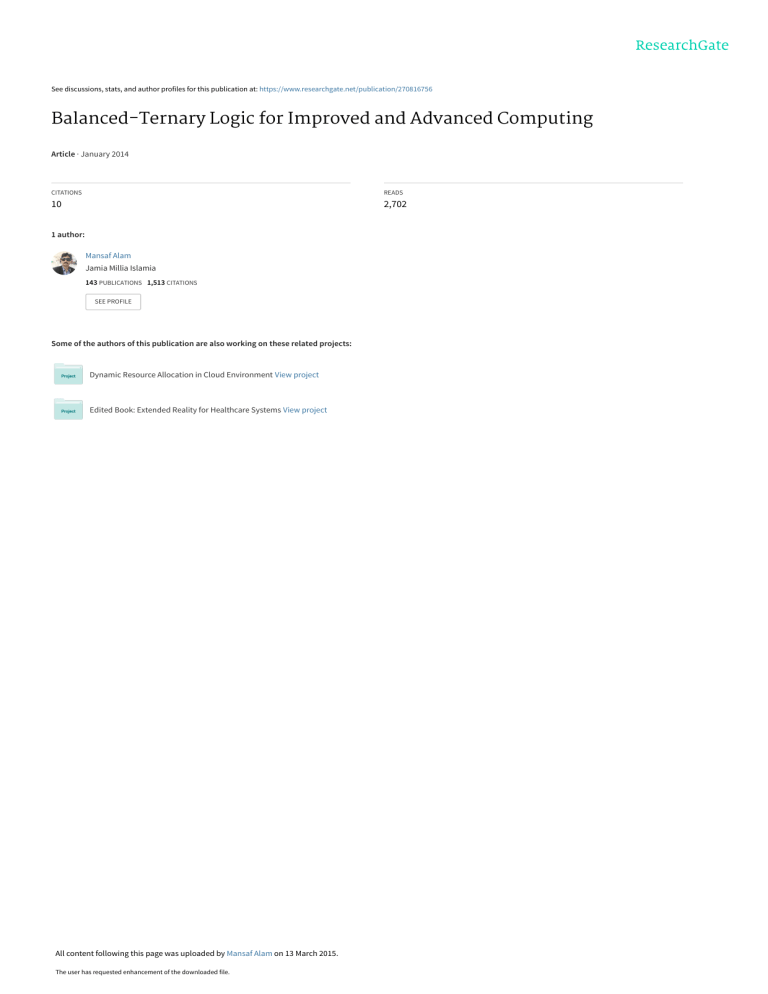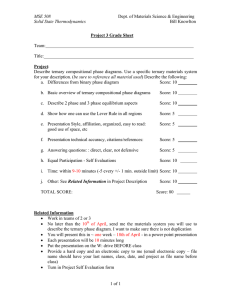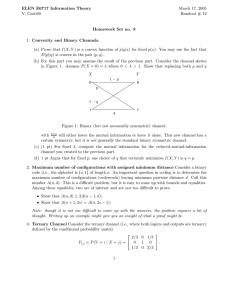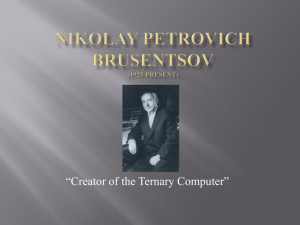
See discussions, stats, and author profiles for this publication at: https://www.researchgate.net/publication/270816756
Balanced-Ternary Logic for Improved and Advanced Computing
Article · January 2014
CITATIONS
READS
10
2,702
1 author:
Mansaf Alam
Jamia Millia Islamia
143 PUBLICATIONS 1,513 CITATIONS
SEE PROFILE
Some of the authors of this publication are also working on these related projects:
Dynamic Resource Allocation in Cloud Environment View project
Edited Book: Extended Reality for Healthcare Systems View project
All content following this page was uploaded by Mansaf Alam on 13 March 2015.
The user has requested enhancement of the downloaded file.
Shamshad Ahmad et al, / (IJCSIT) International Journal of Computer Science and Information Technologies, Vol. 5 (4) , 2014, 5157-5160
Balanced- Ternary Logic for Improved and
Advanced Computing
Shamshad Ahmad, Mansaf Alam
Deptt. Computer Science, JMI, New Delhi.
Abstract:Logical Systems are the essence of our computing
machines. They determine the design, understanding and
most importantly the performance of the compuuting
machines. Contemporary and traditional binary logic is way
too old and limited in application and scope. This paper is
meant to present balanced ternary logic as the most suitable
logical system for our modern computing machines in terms
of performance, simplicity, cost and the future prospects that
it can bestow upon our modern computing machines. The
paper also deals with the fundamental logical gates and
operations in balance ternary logic.
INTRODUCTION:
For decades we have been using computing machines
which work on the concept of fundamental switches having
only two possible states often represented by - 0 and 1, or
ON and OFF.[1] We have witnessed innumerable
advancements and improvements in the realm of these
devices but none to have so strong an impact so as to
question this fundamental property of our “modern”
computers itself. Consequently, we have been working and
improving upon the same binary logic based systems which
has obvious limits.
This paper, however, presents another logical system,
balanced ternary logic for our computing machines and its
advantages over any other proposed logic.
Modern computing devices based on binary logic
implement Boolean logic in which the fundamental
components of the internal circuitry are required to have
only two differentiable states φ1 φ2 [2]from where it gets
the title as base-2 as well. Binary logic became popular due
to the presence of simple and readily available two state
switches and also extensive works on the same logic and
machines. Based on two state-logic, modern computers
lack various aspects expected from a good logical system
which we could recover in our machines by implementing
balanced ternary logic.
Any logical system can have an associated power set PL to
hold elements {φ1, φ2, φ3,..., φn} where n(PL) gives the base
bL of that particular logic. Likewise, (balanced) ternary
logic, also called “flip-flap-flop”[4] may be associated with
a power set defined as PBT to hold elements as PBT = {φ1,
φ2, φ3} and has n(PT)=3 which is ultimately bBT. This one
extra state φ and the fact that bBT =3, make balanced
ternary logic, the supreme logic.
This paper is essentially a work on balanced ternary logic;
we will see how it has an essential advantage over other
possible logics including binary logic as well. The paper
also defines the basic logical gates, the basic logical setups
for this logic and also simple arithmetical operations.
Balanced ternary logic has the least hardware complexity
[5] and thus economical [6]. Unlike binary representation
www.ijcsit.com
of information, there is no difference between “signed” and
“unsigned” numbers when signed numbers are represented
in this logic. To further add to its beauty, the amount of
conditional instructions, using this logic, decrease twice
which necessarily improves the performance and simplifies
things.
Special proofs and arguments in the paper shall further
embark upon the efficiency, simplicity, versatility and
overall supremacy of ternary logic over any other proposed
logic. What if the fundamentals of our machines has better
accordance with the Nature and informal human thinking?
We need not worry; ternary logic has such advantages as
well. Using three different states, it can, on the fundamental
level itself have states referring to ‘True’ ‘False’ and
interestingly ‘Unknown’[7] which is very relevant to
informal human thinking. Moreover, in terms of versatility,
balanced ternary logic, with a clever designing, can also
provide an economical space for the conventional binary
logic as well [12].
BALANCED TERNARY LOGIC:
Balanced ternary logic is a non-binary, multi-valued logic
and special case of ternary logic in which the PT is
PBT ={1,0,-1}, though, for
represented as PBT where
shorthand, we use
PBT ={+, 0, -}It is noteworthy that (φ)
are simple states and that their representation as symbols
and integral values carries no physical significance. Here,
we define ‘Trit’ as the name given to the basic unit of
information in a balanced ternary logic based machine. We
also define ‘tryte’ for our purpose as a collection of six trits
capable of holding 729 unique values.
I - Complexity:
Besides it other numerous advantages, ternary logic turns
out to be the least complex logic for computing. A
proposed method for measuring complexity, CL of a logic
would be by examining the maximum number of
information represented by fixed n number of φ for any
particular logic. Clearly, the logical system representing the
least number of information using n φ would be least
economical and would be the most complex. Conversely,
the logical system that would represent the highest number
of information for n number of φ would win and will be the
most simple (least complex) and most economical [6] of all
the proposed logics and will have a base equal to b.
Let N number of numerical information be represented by
any logical system with base b. We can define a function
f(b) to find N to give the maximum possible number of
information that could be represented using n φ.
f (b) = b ^ (n /b )
Clearly, f(b), at the highest value of N, would correspond to
the base b of most efficient logic. It is seen that with every
5157
Shamshad Ahmad et al, / (IJCSIT) International Journal of Computer Science and Information Technologies, Vol. 5 (4) , 2014, 5157-5160
possible value of constant n, the f(b) for b>1 has the
highest corresponding to b=3 only, which is in fact the base
of ternary logic. It is feasible to restrict all the values of b
to be a positive whole number as the value of b has to be a
counting number only. To verify our result, we find the
solution to f(b)’=0 for b>1
The solution to the above function is e, the base of natural
logarithm which again rounds off to the nearest integer
three or bBT.
Here, we however rely upon the integral values of the
elements of PBT for a better visualization and understanding
of ternary representation. The further simplicity of the
balanced-ternary representation is evident in arithmetical
operations based on balanced ternary logic.
Addition of two ternary numbers can be easily performed
using the below mentioned ternary adders. Another special
feature of ternary logic is that subtraction can also be
performed like addition only that the number to be
subtracted will have original value but with every d
inverted. Thus in balanced ternary logic the most widely
performed operations become simple. Converting numbers
represented in balanced ternary from positive to negative is
easily achieved by inverting every dn to dn’, also referred to
as inversion, as shown in the table below.
D D’ D D’
+
+
0 0 0 0
+ +
Table:1 Inversion operation on trits in balanced ternary.
Fig:1 Plot for describing the effective b along with
highlighted f(b) of similar multi-valued logic.
II – Information Handling and Representation:
Now that it had been established that balanced ternary logic
is the most ‘economical’ and the ‘simple’ logic for modern
computing devices, we consider the fundamental purpose
of computers- information. As stated earlier, PBT = {+, 0, -}
which is just a simple representation for φ for balanced
ternary and that it has no physical significance. However,
this representation under balanced ternary logic shall have
deep impact upon our understanding and the design of any
particular machine itself.
Most of computing is all dealing with information,
essentially represented by φ and inferred as numbers to
perform actions over them. Therefore, a good and simple
way of handling and representation of information becomes
crucial.
As per fundamentals, a 16-bit microcomputer with onboard memory cannot access more than 65 Kilobytes of
memory directly. However, a similar microcomputer with
memory based on (balanced) ternary logic can directly
access as much as 43 Mbytes of equivalent memory which
is a gain of more than 656 times of memory capacity [10].
Also every binary representation of numbers should have a
reserved piece of explicit information to differentiate
between “signed” and ”unsigned” number, balanced
ternary, however, provides more compact way of
representing numerical information without such explicit
piece of information as it is symmetrical and has elements
which are negatives of each other like 1 and -1.
Often, numerical information is stored in a machine using a
particular logic with base b using the following notation:
dnbn-1 + . . + d3b2 + d2b1 + d1b0
Where d, the coefficient is the corresponding digit in the
information represented using a given logical system. In
balanced ternary logic, d may have any value from PBT.
www.ijcsit.com
Understanding Balanced Ternary Arithmetic:
Having shown that balanced-ternary logic is the best
possible logical system for modern computing devices in
terms of simplicity and performance, we will try to set up
the basic idea of fundamental logical gates. Though earlier
attempts have been made to define the fundamental logic
gates like AND and OR as in Kleene and Łukasiewicz logic
[12][8]; however, we have proposed our own TAND and
TOR logics which we have found to be more practical,
mathematically rationale and symmetrical with balancedternary logic. We have assumed that 0 state might possess
either of + and – and that the result of implementing any
logic gate must be as precise as possible. The latter
assumption rules out that we might simply put 0 for every
resultant trit. Also, in designing these gates, have assumed
that + and – are just the negation of each other both in
application and logical understanding. Here, we have
defined the truth tables for these logical gate that are more
consistent with the arithmetical operations and
mathematical rationale based on our assumptions.
I-TERNARY ‘OR’ (TOR) :
Ternary OR gate implements logical disjunction. The
resultant outputs on implementing the proposed TOR gate
has been shown in the following truth table. Though, it is
just a co-incidence that if none of the inputs is 0, and if + is
treated as binary 1 and – as binary 0, we get a OR truth
table similar to binary logic’s, we can exploit it for binary
logic as well.
TOR
+
0
-
+
+
+
+
0
+
0
-
+
-
Table:2, representing the truth table for TOR gate for
balanced ternary logic.
5158
Shamshad Ahmad et al, / (IJCSIT) International Journal of Computer Science and Information Technologies, Vol. 5 (4) , 2014, 5157-5160
II- TERNARY ‘AND’ (TAND) :
Ternary AND gate implements logical conjunction. The
resultant outputs on implementing the proposed TOR gate
has been shown in the following truth table.
TAND + 0 +
+ 0 0
0
0 0 0
0 0 Table:3 representing the truth table for TOR gate for
balanced ternary logic.
It is noteworthy, as assumed earlier, in the above table that
the resultant value of the above defined gates has been on
the basis that they have a hundred percent chance on the
implementation of these logical gates. Now that these two
fundamental gates have been defined, the other two other
frequently used gates- NAND and NOR gates for balanced
ternary logic may be defined using the above logic gates by
simply inverting (inversion, defined earlier) results of
corresponding logics using Table:1.
III- HALF ADDER FOR BALANCED TERNARY
LOGIC:
Based on the above defined fundamental gates, we build a
balanced ternary half adder to take in two trits and process
them to give sum trit S and carry trit C. It uses two TAND
gates, a TOR gate, a inverter (shown in block) for
inversion, and a special switch sw which allows the input
‘through’ it only when both the externally controlling
inputs are non-0 otherwise it results in 0. The resultant
outputs for corresponding inputs have been shown in table
4.
Fig:2 Balanced-Ternary Half Adder logic diagram.
INPUT OUTPUT
X1 X2
S
C
+
+
+
+
+
0
0
+
0
0
0
0
0
0
0
+
+
0
0
0
+
0
+
0
0
0
Table:4 Resultant outputs on implementing balanced
ternary half adder on every possible set of inputs.
www.ijcsit.com
IV- FULL ADDER:
A balanced-ternary full adder [fig 3] is designed upon the
above defined ternary half adder. It takes in three trits as
input; essentially designed upon three ternary half adders, it
returns two trits- sum So and carry Co. To construct balanced
ternary full adder, we assume half-adders THA defined
earlier as its fundamental structures. It uses three ternary
half adders to perform the operations successfully. The
resultant values after implementing this balanced-ternary
full adder for corresponding inputs is shown in table 5.
Fig:3 balanced ternary full adder logic diagram.
Note here that that C from THA 3 has been left out as
unconsidered and it still causes no problem. We also found
that in every possible case, its state will remain 0 only.
Input
I1 I2
- + +
- + +
- + +
- 0
+ 0
- 0
+ 0
- 0
+ 0
- +
+ - +
+ - +
+ 0 0 +
0 0 +
0 0 +
0 0
0 0
0 0
Cin
+
0
0
+
+
0
0
+
+
0
0
+
+
0
0
+
+
0
Output
S0 C 0
0
0
+
+ +
0
+ 0
+ +
0
+ 0
0
0
0
0
0
+ 0
0
0
0
0
+ 0
0
+ +
0
+ 0
0
0
0
0
0
+ 0
0
0
Table:5 Resultant outputs on implementing balanced
ternary full adder on every possible set of inputs.
5159
Shamshad Ahmad et al, / (IJCSIT) International Journal of Computer Science and Information Technologies, Vol. 5 (4) , 2014, 5157-5160
‘NATURAL’ NATURE OF BALANCED TERNARY:
The implementation of ternary logic gives the machines
more prospects for informal and natural thinking over
prevailing binary logic which has only two recognizable
states corresponding to true or false only, at the
fundamental level. Although, instances of informal thinking
and improved cognitive nature can be achieved on binary
machines as well but it is not pure or native. However, in
ternary logic, due to the fact that balanced ternary provides
an extra value to be translated into anything else other than
formal ‘true’ and ‘false’ like ‘maybe’. In fact, ternary logic
is the most economical logic that could achieve this ability
up to the fundamental level of computing without any
explicit definition.
For balanced ternary logic, we can assume a system Ă with
elements having the general logical meaning they carry
{True, False, may be or unknown} which correspond to
different values on mapping to the set PBT [11]. We should
try to map natural propositions, p to a specific element in in
the system A. Clearly, if we successfully map Natural
Propositions to A, we can easily figure out mapping m for
every p in Pbt as follows:
Let p : Ă->Pbt
Then, m(p)= {1, if p is true }
{-1, if p is false}
{0, if p can’t be mapped to 1 or -1}
It is clear that balanced ternary logic provides a
fundamental representation to all the natural propositions
which may be ‘true’, ‘false’ or ‘maybe’. It can be inferred
that due to the informal thinking flexibility provided by
balanced ternary logic, it will also provide improved
suitable logical system for improved cognitive thinking as
well.
If a machine be designed properly with the implementation
of balanced ternary logic, it would also perform far better
than contemporary binary machines in AI domains as well.
For instance, balanced ternary logic based machines have
big hopes on their side to performance extremely well on
natural thinking tests such as Turing test [14] as they have
an extra state to invoke something other than the
conventional ‘true’ and ‘false’. If designed properly upon
balanced ternary logic, machines could achieve somewhat
human-like thinking. Beyond any doubt they will also
improve techniques such as Natural Language Processing
(NLP) as well.
Converting chunks of text into more formal representations
such as first-order logic structures make it easier
for computer programs to manipulate. Natural language
understanding involves the identification of the intended
semantic from the multiple possible semantics which can
be derived from a natural language expression which
usually takes the form of organized notations of natural
languages concepts [13]. True/ false/ Unknown or Maybe,
provide more prospects for improved sematic formalization
and thus improved NLP.
www.ijcsit.com
View publication stats
CONCLUSION:
Implementation of ternary logic has huge advantages over
prevailing binary logic. Implementation of any logic
becomes easy once we understand that the fundamental
structure of any hardware for a specific machine doesn’t
depends on its driving force, for instance electric current
but on its(here, current’s) effects. It allows a neat and smart
representation of information and also is very consistent
with its logical arithmetic. -The implementation of
balanced ternary logic will unlock innumerable horizons
for the future prospect of computing devices. To conclude,
balanced ternary logic is the overall best logical system for
improved computing when all the factors including
performance, efficiency, durability and robustness are taken
under consideration.
[1]
[2]
[3]
[4]
[5]
[6]
[7]
[8]
[9]
[10]
[11]
[12]
[13]
[14]
REFERENCES:
Boole, George (2003) [1854]. An Investigation of the Laws of
Thought. Prometheus Books. ISBN 978-1-59102-089-9.
Paul, Tomassi (1999). Logic. Routledge. p. 124. ISBN 978-0-41516696-6.
Lou Goble (2001). The Blackwell guide to philosophical logic.
Wiley-Blackwell. p. 309. ISBN 978-0-631-20693-4.
Knuth, D. E.; The art of computer programming, Vol.2.
Seminumerical algorithms. -Addison-Wesley, 1969.
Liu D, Swenson C. Trading speed for low power by choice of supply
and threshold voltages. IEEE J Solid-State Circuit 1993.
Hurst , S.L, ”Multiple-valued logic- its status and its future”, IEEE
Transactions
on Computers, vol. C-33, no.12, pp.1160-1179,
December 1984.
The Penguin Dictionary of Mathematics. 2nd Edition. London,
England: Penguin Books. 1998. p. 417
Lucasiewicz, Jan O Logice Tr´ojwarkoscioewj English translation:
On three-valued logic, in L. Borkowski (ed.), Selected works by Jan
Lukasiewicz, North-Holland, Ams-12terdam, 1970, pp. 87-88
Cignoli R. and D’Ottaviano I. and Mundici D. Algebra das l´ogicas
de Lucasiewicz´,Universidade Estadual de Campinas, UNICAMP
1995.
Stokes, Jon (2007). Inside the machine: an illustrated introduction to
microprocessors and computer architecture. No Starch Press. p. 66.
ISBN 978-1-59327-104-6.
Jorge Pedraza, Fundamentals of Ternary Logic, June 2009
Kleene, Josephson 1967. Mathematical Logic. John Wiley. Dover
reprint, 2001. ISBN 0-486-42533-9.
Yucong Duan, Christophe Cruz (2011), Formalizing Semantic of
Natural Language through Conceptualization from Existence.
International Journal of Innovation, Management and Technology
(2011) 2 (1), pp. 37-42.
Turing, Alan Computing Machinery and Intelligence, Mind, 1950
5160

![VARIABLE, OPERATOR AND EXPRESSION [SET – 1]](http://s2.studylib.net/store/data/017977543_1-63cdff75b6f4ecbff2fecef218806221-300x300.png)


